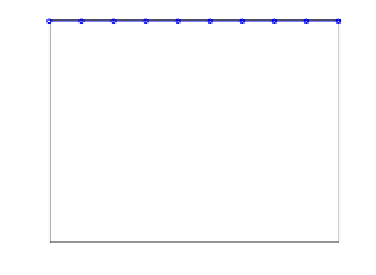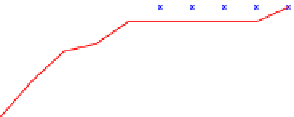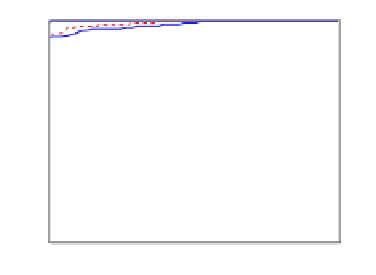Information Technology Reference
In-Depth Information
Table 1.
Experiment 2 results (in %) using our database
Training error recog. verif. rate
images
rate
rate at 0.1% FAR
8
0.13
99.87
99.87
7
0.18
99.82
99.87
6
0.66
99.33
99.67
5
0.63
99.37
99.37
4
0.89
99.11
98.76
3
1.32
98.68
98.76
2
3.10
96.90
95.69
1
14.41
85.59
79.46
100
100
99.8
99
99.6
98
99.4
97
99.2
96
99.0
95
98.8
94
98.6
93
98.4
92
8 training images
7 training images
6 training images
5 training images
8 training images
7 training images
6 training images
5 training images
98.2
91
98.0
90
1
2
3
4
5
6
7
8
9
10
10
−3
10
−2
10
−1
10
0
Rank
False Accept Rate (log scale)
(a) (b)
Fig. 6.
Experiment 2 results for the extended Yale B database. (a) CMC curves for 5
to 8 training images and the corresponding (b) ROC curves.
were left with image 5 only. This order was chosen so that there is at least one
frontal lit image in the training data and the lateral images are the ones that
make a smaller angle with the optical axis. This is sensible from a practical stand
point because placing lights at smaller angles requires less space.
Fig. 6 shows the CMC and ROC curves of our algorithm on the extended Yale
B database and a summary of the results is presented in Table 2. Fig. 7 shows
plots of error rates for different subsets of the database for direct comparison
with [13]. Our algorithm achieved 100% recognition rate and 100% verification
rate at 0.001FAR on this database. On the CMU-PIE database [20], with just five
images used for training and the remaining for testing, our approach achieved
100% recognition rate and 100% verification rate at 0.01% FAR. Using three
training images, the recognition rate dropped to 94.6%.
4.3 Experiment 3
In this experiment, we study the effects of time lapse between training and test
images. This experiment cannot be performed on the Yale B and CMU-PIE
databases because they were acquired in a single session per subject.Therefore,
we perform this experiment on our database only. The setup of this experiment
is similar to experiment 2 except that the system is trained using images from







































































































































































































































Search WWH ::

Custom Search